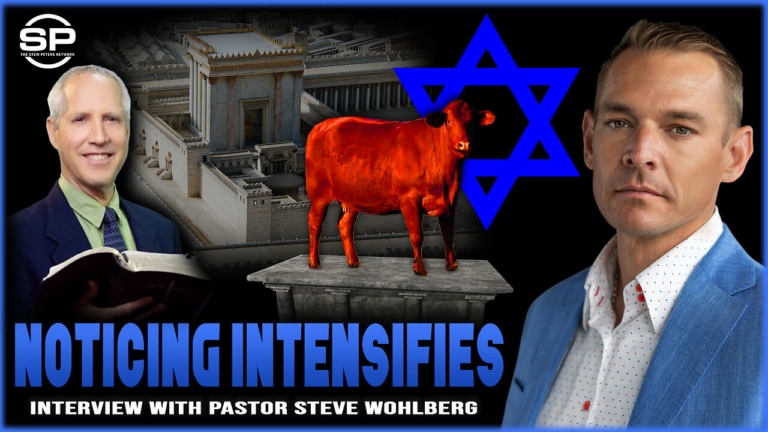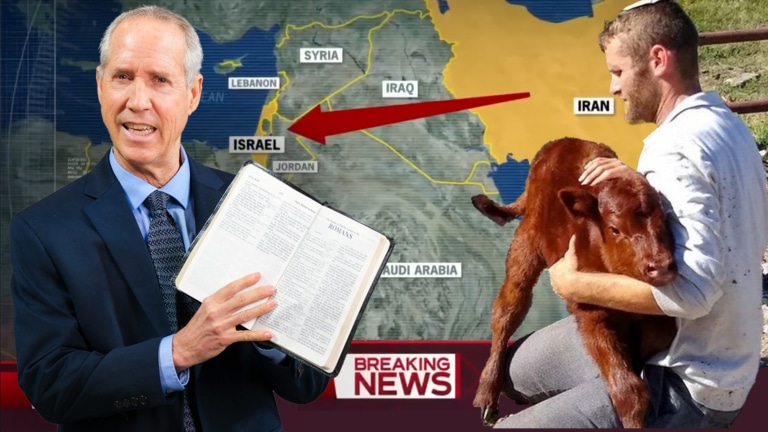Prophecy-minded Christians all over Planet Earth often engage in a fierce debate about whether Jesus Christ will return for His Church before the seven years of tribulation (the “pre-trib” view), in the midst of the seven years (the “mid-trib” view), or at the end of the seven years (the “post-trib” view). Yet by far the most explosive question few seem to be asking is: Is an end-time “seven-year period of tribulation” really taught in the Bible in the first place?
In 1945, after months of agonizing deliberation, U.S. President Harry Truman finally issued orders to drop two atomic bombs upon Japan in an attempt to end World War II. On August 6, the “Little Boy” fell on Hiroshima. Three days later, the “Fat Man” was released over Nagasaki. Approximately 130,000 people were instantly vaporized. Many heated discussions have occurred as to whether or not it was the right thing to drop those bombs. One thing’s for sure, in the minds of those who made that fearful decision, they believed it was for the ultimate good of America.
Dear friend, it is for the benefit of Christians everywhere that God’s bomb of truth should now be released over what I have come to call, “The 70th week of Daniel Delusion.”
As we have seen, the entire 7-year theory is based on Daniel 9:27, which says:
He shall confirm the covenant with many for one week: and in the midst of the week he shall cause the sacrifice and the oblation to cease… (Daniel 9:27 KJV ).
This may shock you, but historically, the vast majority of well-respected Bible scholars have not applied Daniel 9:27 to a seven-year period of tribulation at all. Neither have they interpreted the “he” as referring to a future antichrist (as many do today) . Instead, they applied it to Jesus Christ.
Notice what the world-famous Bible commentary written by Matthew Henry says about Daniel 9:27: “By offering himself a sacrifice once and for all he [Jesus] shall put an end to all the Levitical sacrifices.” Thus Matthew Henry applied Daniel 9:27 to Christ, not antichrist. Another famous commentary written by British Methodist Adam Clarke says that during Daniel 9:27’s “term of seven years,” Jesus Himself would “confirm or ratify the new covenant with mankind.” Another dusty Bible commentary reveals: “He shall confirm the covenant—Christ. The confirmation of the covenant is assigned to Him.”
Here’s one more statement from a book called, Christ and Antichrist, published in 1846 by the Presbyterian Board of Publication in Philadelphia. On page 2, under Recommendations, are endorsements from many Presbyterian, Methodist, and Baptist ministers, including an official representative of the Southern Baptist Convention. Commenting on the final week of Daniel 9:27, that ancient volume states:
…sometime during the remaining seven, he [the Messiah] was to die as a sacrifice for sin, and thus bring in “everlasting righteousness.” Here are allusions to events so palpable, that one would think, the people among whom they occurred, could not possibly have misapplied the prophecy.
Okay, here we go. The following ten points provide logical and convincing evidence that Daniel’s famous 70th week has no application to any future seven-year tribulation at all. Rather, this great prophetic period was definitely fulfilled nearly two thousand years ago.
- The entire prophecy of Daniel 9:24-27 covers a period of “seventy weeks,” or 490 years. Logic requires that “seventy weeks” refers to one consecutive block of time, in other words, to seventy straight sequential weeks. There is no example in Scripture (or anywhere else!) of a stated time period starting, stopping, and then starting again. All biblical references to time are consecutive: 40 days and 40 nights (see Genesis 7:4), 400 years in Egypt (see Genesis 15:13), 70 years of captivity (see Daniel 9:2), etc. In Daniel’s prophecy, the “seventy weeks” were to begin during the reign of Persia and continue to the time of the Messiah.
- Logic also requires that the 70th week follow immediately after the 69th week. If it doesn’t, then it cannot properly be called the 70th week!
- It is illogical to insert a 2,000-year gap between the 69th and 70th week. No hint of a gap is found in the prophecy itself. There is no gap between the first seven weeks and the following sixty-two weeks, so why insert one between the 69th and 70th week?Note: If you told your child to be in bed in 70 minutes, you obviously would mean 70 consecutive minutes. What if five hours later your fully awake son said, “But dad, I know 69 minutes have passed, but the 70th minute hasn’t started yet!”? After receiving an appropriate punishment, he would be swiftly sent to bed.
- Daniel 9:27 says nothing about a seven-year period of “tribulation,” a “rebuilt” Jewish temple, or any “antichrist.”
- The stated focus of this prophecy is the Messiah, not the antichrist. After the Messiah is “cut off” (referring to Christ’s death), the text says, “And the people of the prince who is to come shall destroy the city and the sanctuary.” In the past, this has been consistently applied to the destruction of Jerusalem and the second temple by Roman armies led by Prince Titus in A.D. 70.
- “He shall confirm the covenant.” Paul said “the covenant” was “confirmed before by God in Christ” (Galatians 3:17). Jesus Christ came “to confirm the promises made to the fathers” (Romans 15:8, emphasis added). In the King James Version, Daniel 9:27 doesn’t say ” a covenant” or peace treaty, but ” the covenant,” which applies to the New Covenant. Nowhere in the Bible does the antichrist make, confirm, or break a covenant with anyone. The word “covenant” is Messianic, and always applies to the Messiah, not the antichrist.
- “He shall confirm the covenant with many. ” Jesus Christ said, “This is My blood of the new covenant, which is shed for many… ” (Matthew 26:28). Behold a perfect fit! Jesus was quoting Daniel 9:27 specifically.
- “In the midst of the week he shall cause the sacrifice and the oblation to cease.” After exactly three and a half years of holy ministry, Jesus Christ died on the cross, “in the midst of the week [in the middle of the seven years].” At the exact moment of His death, “the veil of the temple was torn in two from top to bottom…” (Matthew 27:51). This act of God signified that all animal sacrifices at that moment ceased to be of value. Why? Because the Perfect Sacrifice had been offered!
- “For the overspreading of abominations he shall make it desolate.” “The abomination of desolation” (see Matthew 24:15) is not a simple subject, yet we know that Jesus clearly applied this event to the time when His followers were to flee from Jerusalem before the destruction of the second temple in A.D. 70. In a parallel text to Matthew 24:15, Jesus told His disciples, “When you see Jerusalem surrounded by armies [Roman armies led by Prince Titus], then know that its desolation is near ” (Luke 21:20, emphasis added). The disciples did “see” those very events. Because of the “abominations” of the Pharisees, Jesus told them, “See! Your house is left to you desolate” (Matthew 23:38). Thus Gabriel’s statement in Daniel 9:27 about Jerusalem becoming “desolate” was perfectly fulfilled in A.D. 70.
- Gabriel said that the 70-week prophecy specifically applied to the Jewish people (see Daniel 9:24). During the period of Christ’s public ministry of 3 ½ years, the Master’s focus was largely upon “the lost sheep of the house of Israel” (Matthew 10:6). After His resurrection and then for another 3 ½ years, His disciples preached mostly to Jews (see Acts 1-6). After that second 3 ½ year period, in 34 A.D., the bold Stephen was stoned by the Jewish Sanhedrin (see Acts 7). This infamous deed marked the then-ruling Jewish leaders’ final, official rejection of the gospel of our Savior. Then the gospel went to the Gentiles. In Acts 9, Saul became Paul, the “apostle to the Gentiles” (Romans 11:13). In Acts 10, God gave Peter a vision revealing it was now time to preach to the Gentiles (see Acts 10:1-28). Read also Acts 13:46. Thus approximately 3 ½ years after the crucifixion— and at the end of the 70-week prophecy given for the Jewish people—the gospel shifted to the Gentiles exactly as predicted in Bible prophecy.
The explosive evidence is overwhelming! Point by point the events of Daniel’s 70th week have been fulfilled in the past. These eight words found in Daniel 9:27: “confirm…covenant…many…midst…sacrifice…cease… abominations…desolate” all find perfect fulfillment in Jesus Christ and early Christian history.
In the words of that 1846 Presbyterian publication,
The seventy weeks of Daniel therefore, have certainly ended many centuries ago. We are not to look to the future for the fulfillment of these predictions. We must look to the past. And if to the past; where is there one who can have any adequate claims to being the subject of these prophecies, but Jesus? He, and he only can claim them; and to him they most certainly refer.
…one would think, the people [the Jews] among whom [these events] occurred, could not possibly have misapplied the prophecy.
But they did. In fact, one major reason why the Jewish nation as a whole failed to receive its Messiah was because its scholars misinterpreted Daniel 9:27. They failed to see Jesus Christ as the predicted One who would die in the midst of the 70th week! Amazingly, the exact same thing is happening today. Sincere Christian scholars are now misapplying the very same prophecy.
The entire “seven-year period of tribulation” theory is an end time delusion, a massive mega-myth. It may even go down in history as the greatest evangelical misinterpretation of all time. The whole concept is like a gigantic bubble. Once Daniel 9:27 is correctly understood and the sharply-pointed pin of truth is inserted, “Pop goes the seven years!” It’s a fact: There is no text in the Bible which teaches a “seven-year tribulation.” If you hunt for it, you’ll end up like Ponce de Leon searching for the mystical Fountain of Youth, but never finding it.
The current debate and tremendous confusion over pre-trib, mid-trib, or post-trib is really a smoke screen of the enemy to hide the real issue. What is the real issue? We’ll find out when we study what the Book of Revelation truly teaches about Israel, Babylon the Great, and Armageddon.
Taken from Chapter 5 of Steve Wohlberg’s book, End Time Delusions: The Rapture, the Antichrist, Israel, and the End of the World.






